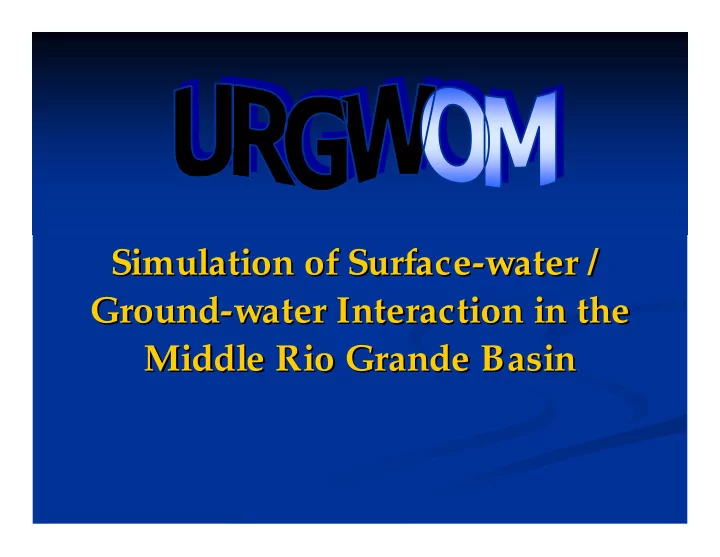

Simulation of Surface- -water / water / Simulation of Surface Ground- -water Interaction in the water Interaction in the Ground Middle Rio Grande Basin Middle Rio Grande Basin Drafted 4/12/06
Contributors Contributors � D. Michael Roark, USGS D. Michael Roark, USGS � � Nabil Nabil Shafike Shafike, New Mexico Interstate Stream , New Mexico Interstate Stream � Commission Commission � Michael Michael Gabora Gabora, New Mexico Interstate Stream , New Mexico Interstate Stream � Commission Commission
Goals Goals � Goal: Develop unified water operations model for the Goal: Develop unified water operations model for the � Upper Rio Grande Basin Upper Rio Grande Basin � Common water operations tool within the Rio Grande Basin Common water operations tool within the Rio Grande Basin � to coordinate diverse entities / interests to coordinate diverse entities / interests � Decision Decision- -making tool to address contemporary water making tool to address contemporary water � management needs management needs � Capable of representing the physical, accounting, and Capable of representing the physical, accounting, and � operational complexities of the Rio Grande Basin operational complexities of the Rio Grande Basin
Location of study Location of study URGWOM URGWOM area (map) area (map) Model Area Model Area Colorado – New Mexico state line to Ft. Quitman, Texas • 3 Rio Chama reservoirs • 3 Rio Grande main stem reservoirs • Several other tributary reservoirs
Location of study Location of study Area of Significant Area of Significant area (map) area (map) GW/ SW Interaction GW/ SW Interaction Middle Valley - from Dam at Cochiti Lake to the upper end of Elephant Butte Reservoir Lower Valley – from Dam at Caballo Reservoir to El Paso, TX
Physical Simulation Physical Simulation GW/ SW Interaction? GW/ SW Interaction? � Current Model Current Model � � Uses regression relations for river seepage Uses regression relations for river seepage � � Feedback loop to correct for too much or too little water in Feedback loop to correct for too much or too little water in � river and drains river and drains � Model needs flow input in each reach Model needs flow input in each reach � � Many alternatives explored Many alternatives explored �
Current techniques Current techniques of simulation of simulation
Proposed methods for Proposed methods for SW/ GW interaction SW/ GW interaction � Simulation of physical system Simulation of physical system � � Simulation of GW/SW interaction using Simulation of GW/SW interaction using � � RiverWare only (GW RiverWare only (GW- -object) object) � � Dynamic interface between RiverWare and MODFLOW Dynamic interface between RiverWare and MODFLOW �
Proof of Concept Model Proof of Concept Model � Using RiverWare only for simulation Using RiverWare only for simulation � � Testing of new RiverWare Methods Testing of new RiverWare Methods � � Testing coarse discretization Testing coarse discretization � � Test reach chosen from gages Rio Grande below Test reach chosen from gages Rio Grande below � Cochiti to Rio Grande at Albuquerque Cochiti to Rio Grande at Albuquerque � Complexity Complexity � � River both loses and gains River both loses and gains �
Cochiti Lake Discretization of the Discretization of the POC Model Area POC Model Area Jemez 1. Six GW reaches Reservoir 2. Three areas in each reach 3. Each area simulated with a RiverWare ground-water object Albuquerque
Discretization of the POC Discretization of the POC Model Area Model Area Riparian Percolation from Percolation from Evapotranspiration R i v e r s i d e Riverside Irrigation Irrigation Rio Grande D r a i n Drain Canal Seepage y y r r a a d d GW West GW River GW East n n u u 80 ft o o B B w w o o l l F F o o N N Variable Head Boundaries Heads from Regional MODFLOW Model Head Dependant Flow
Cochiti to San Felipe Cochiti to San Felipe part of POC Model part of POC Model
San Felipe to San Felipe to Albuquerque part of Albuquerque part of POC Model POC Model
Preliminary Calibration River Flow at Rio Grande at Albuquerque 2000 CentralGage.Inflow CentralHistoricalGage.Inflow 1500 FLOW, IN CFS 1000 500 0 Jan Feb Mar Apr May Jun Jul Aug Sep Oct Nov Dec Jan 2000
Probability density function of residual (historical - simulated) at Central Ave. gage for the reach San Felipe to Albuquerque, Year 2000 0.25 Within 100 cfs 55% of the time 0.20 0.2 0.19 Mean Error: 7.4 cfs Absolute Mean Error: 81.7 cfs 0.16 0.15 Probability 0.15 0.1 0.09 0.08 0.05 0.05 0.03 0.02 0.01 0 -450 -400 -350 -300 -250 -200 -150 -100 -50 0 50 100 150 200 250 300 350 400 450 Residual (cfs)
Conclusions Conclusions � Using the ground Using the ground- -water object, Pros and Cons water object, Pros and Cons � � Pros: Pros: � � Improving the physical representation of surface Improving the physical representation of surface- -water / ground water / ground- - � water interaction in the middle valley. water interaction in the middle valley. � Simulating the impact of deep aquifer pumping on surface water. Simulating the impact of deep aquifer pumping on surface water. � � Cons: Cons: � � Requires more data about the physical system. Requires more data about the physical system. � � Many more objects Many more objects � � Continued development of simulation of middle Continued development of simulation of middle valley valley �
Recommend
More recommend